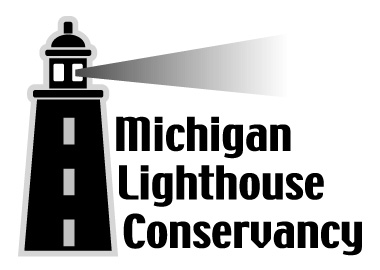
The
Fresnel Lens
The Fresnel lens is the 1822 invention of French physicist Augustine Fresnel
who invented a lens that would make his name commonplace along the
seacoasts of Europe and North America. Most lenses
were handmade and shipped unassembled from France. Others were made in
England. Early lens designs resembled a giant glass beehive, with a light at the
center (see examples below). The lens could be as tall as twelve feet high with concentric rings of
glass prisms above and below a center drum section to bend the light into a narrow beam.
Later designs incorporated a bull's eye design into the
center of the lens shaped like a magnifying glass, so the concentrated beam
was even more powerful. Tests showed that while an open flame lost nearly
97% of its light, and a flame with reflectors behind it still lost 83% of
its light, the Fresnel lens was able to capture all but 17% of its light.
Because of its amazing efficiency, a Fresnel lens could easily throw its
light 20 or more miles to the horizon.
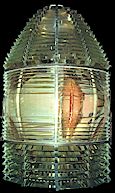
Early Fresnel lenses were of standard shapes and designs with little deviation such as the one pictured above. They had an oil lantern that burned constantly from dusk until dawn with no flashing or blinking as you may think of them today. Once they started being used along the coasts in greater numbers the mariner could not tell where they were at night because nothing distinguished one light from another. For a lighthouse to be effective as an aid to navigation, it not only had to be seen, it also had to be identified as a unique location. This was necessary if ships were to use it to determine their own location and avoid hazards. From here on out different lenses were made with different characteristics and as such required different lens designs. This meant that a lot of lenses were now unique because they would require flash panels or bull's eyes to distinguish one light from the next. The need to clearly identify each lighthouse was often solved by a specific pattern of flashes per minute. Although sometimes lighthouses identified themselves by using colored light, most made use of a flash of light, followed by a period of darkness. This pattern was called the lighthouse's "characteristic." Once electricity was introduced a light could use a flashing mechanism to give it a unique characteristic flash pattern. Now a sea captain could tell where he was by looking at a map and the flash pattern of the light and tell he was in Maine or Massachusetts.
There are many sizes of Fresnel lenses, called 'orders', the largest being a
first order, which is made up of hundreds of glass prisms. The lenses
decrease in size through second order, third order, etc. Some have red
panels, in order to shine a red light seaward. The glass prisms are shaped
and positioned in such a way that the light from the single source inside
the lens is reflected outward horizontally through each prism. In this way,
the light streaming outward in all different directions is maximized into
large beams shining out to sea. The number of beams depend on the
configuration of the prisms, which can vary greatly. Different lighthouses
must display beams for differing periods of time in order to be
distinguished from one another.
Generally Fresnel lenses are divided into 7 classes (called "orders"). The
order is determined by the distance of the flame to the lens. The "First
Order Fresnel lens" is the largest lens widely used, and was installed in
many of the largest "sea coast lights". Two larger sizes were built in
limited quantity and they are the for a couple of special installations. Smaller Fresnel lenses, such as the sixth-order
lens, were installed in smaller lighthouses, such as breakwater lighthouses.
See the chart below of lens orders which represents standard beehive type
designs in general and not varying at all in characteristics..
Chart of Fresnel Lenses*
Order by Size
| Order | Height | Inside Diameter |
|---|---|---|
| First | 7' 10" | 6' 1" |
| Second | 6' 1" | 4' 7" |
| Third | 4' 8" | 3' 3" |
| Third and 1/2 | 3' 0" | 2' 5 1/2" |
| Fourth | 2' 4" | 1' 8" |
| Fifth | 1' 8" | 1' 3" |
| Sixth | 1' 5" | 1' 0" |
*Source: Guardians of the Golden Gate: Lighthouses and Lifeboat
Stations of San Francisco Bay
Ralph Shanks and Lisa Woo Shanks, editor. 1995, Costano Books, ISBN:
0-930268-08-3.
Some photos of different types of lenses are below.
First Order Lens
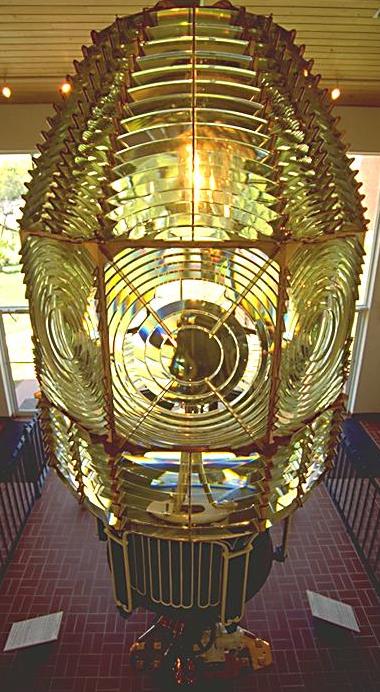
A First Order lens found at the Ponce De Leon Inlet Lighthouse near Daytona Beach Florida. No First Order lenses were used in the Great Lakes. These lenses are huge!
Second Order Lens
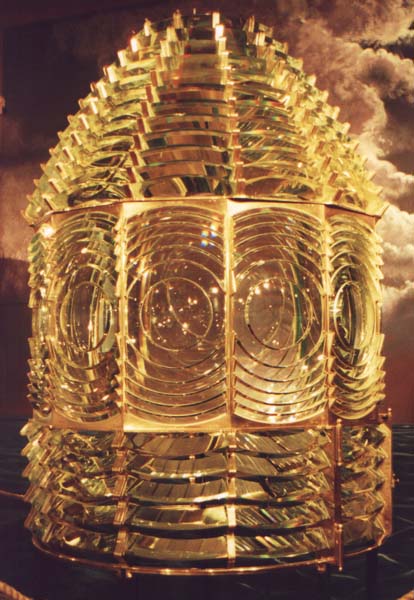
A Second Order lens from Standard's Rock lighthouse in Lake Superior. One of only a small handfull of this size lenses used in the Great Lakes. This one has bull eyes in the center and is meant to create a flash pattern as it is rotated.
Third Order Lens
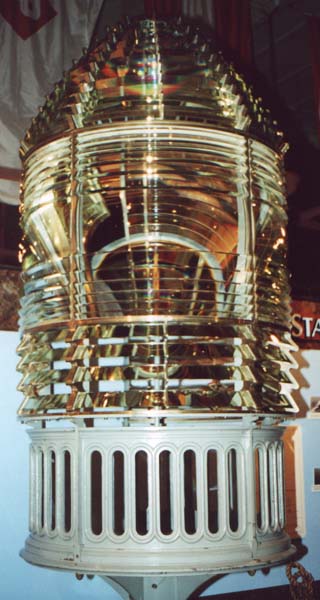
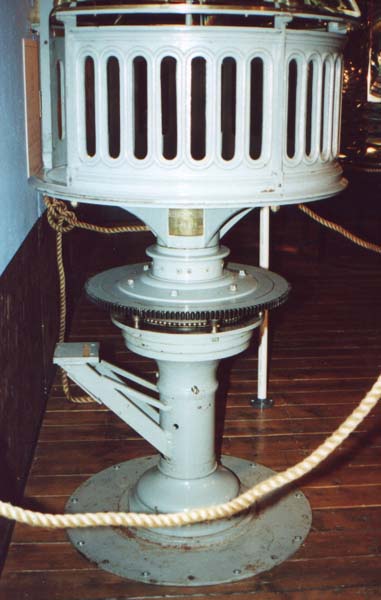
This is a Third Order lens. This lens is a fixed lens and not meant to be rotated. Some of these lenses are on display around Michigan Museums. This one is the Big Bay Point lens on display in Marquette.
Third and a Half Order Lens
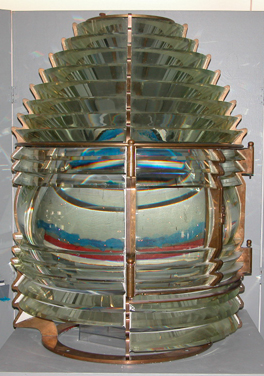
This Third and a Half Order lens was one typically built for service on the Great Lakes as it was a medium size between a Fourth and Third Order lens, a Fourth was to small and a Third was just to large for the intended use. This is a fixed lens and not a rotating lens. This is the Gray's Reef lens and can be seen at the Charlevoix Historical Society Museum.
Fourth Order Lens

A Fourth Order lens was very typical on the Great Lakes and especially Michigan. A lot of pier head lights and lighthouses displayed one of these lenses. It was a lens size most commonly used throughout the lakes and some ocean coastal harbor stations.
Fifth Order Lens
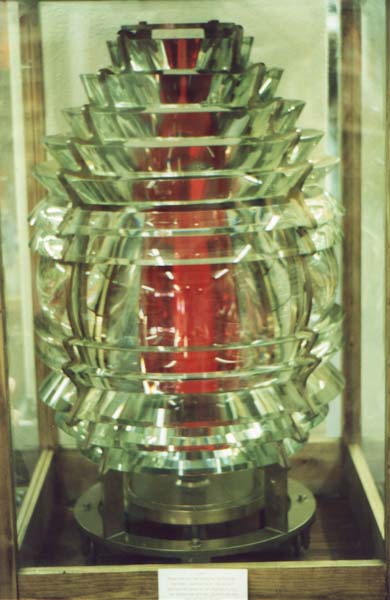

This is a Fifth Order lens from the Ontonagon lighthouse. This lens exhibited a red light and as such had a red chimney placed around the lamp inside to make the lens color change. This is what is called a beehive type design. Although some lenses had flash panels installed on them, this one does not. This lens can be seen in downtown Ontonagon at the local museum.
Sixth Order Lens
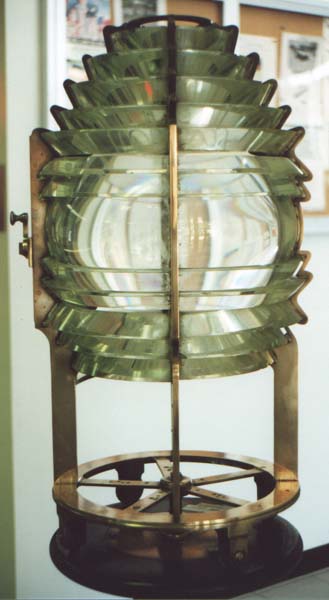
This Sixth Order lens is the smallest of the lenses made for lighthouses. It was designed for small light stations or pier head type lights. This one is on display inside the Saulte Saint Marie Coast Guard Station. These lights were common in the Great Lakes on small harbors or piers.